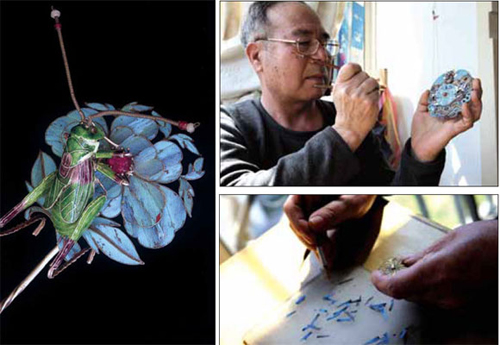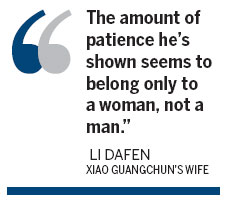
Clockwise from top right: Dian cui master Xiao Guangchun works on a piece of jewelry at his home in Beijing. A piece of dian cui work needs a large amount of patience and time. A dian cui hairpin of the Qing Dynasty. Photos by Jiang Dong / China Daily
Dian cui, the art of applying kingfisher feathers onto accessories, requires skill and a lot of patience. But like many age-old techniques, it risks being lost forever. Zhao Xu has the story.
Think gold is precious? If you listen to Xiao Guang-chun, the shimmering metal is almost nothing compared to another of Nature's treasures - this one commands a much more lustrous shine, a shine charged with an irrepressible, time-transcending life force.
It is the shine of kingfisher feather, the feather of a small, jewel-toned bird that Xiao has been applying tirelessly, for the past four decades, on the surfaces of antique golden accessories, in an effort to resuscitate their time-worn beauty and charm.
"Aesthetically, our ancestors placed the kingfisher feather way ahead of gold," says Xiao, pointing to the fact that the latter had been reduced to a mere "base" status in almost all head accessories made for upper-class court ladies during China's dynastic periods.
"Despite gold being valued as the most precious metal - and a form of currency - at that time, in creating jewelry, artisans routinely covered the entire surfaces of their gold-wrought designs with the feather, leaving only golden fringes to set off and accentuate the plume's iridescent blue hue.
"These days, the color is sometimes referred to as 'Turkish blue', after the Turkish turquoise I suppose. But in my view, it's a shade of its own, undefinable by any other worldly thing," says Xiao. "Mother Nature has only this one tube of paint and she lavishes it on the wings of this lucky little bird we call kingfisher."
But there's one thing that could, hopefully, do justice to the beauty of the feather. It's the name assigned to Xiao's art.
"People call the process dian cui, meaning a dipping of blue," he says. "It so perfectly captures the silken texture of the plume, which, under sunlight, seems to melt into a reflective and miraculous pool of indigo."
Not only that, the very term also hints at a dian cui master's light, delicate touch when letting the color flow onto the golden surfaces, one piece of feather at a time. It's a lightness rooted in decades of practice, and rendered possible by a calm, undisturbable state of mind.
"The amount of patience he's shown seems to belong only to a woman, not a man," says Li Dafen, Xiao's wife for nearly 40 years.
Like all artisans who have grown up knowing no god other than the god of his own calling, the 63-year-old Xiao talks fervently about his skills, which is deceptively simple yet punishingly complicated and time-consuming.
"To make sure the feathers stay there firmly and smoothly, for hopefully a hundred years or two, you have to go through a process dictated by strict rules," he says. It's also a process filled with diligently guarded trade secrets. Xiao's skills was passed on to him, exclusively, by his late father, a dian cui master.
"My father personally embodied for me the dying art. And he taught me everything there's to know about it, at a time when the possession of such rare skills could lead to persecution," Xiao says. He is talking about the country's decade-long "cultural revolution" (1966-76), during which everything luxurious was denounced as "immoral".
"My father, who had been doing dian cui since he was 12, was barred from work. In retrospect, what was the greatest pathos for him was a stroke of luck for me, since for the first time, he truly opened up and revealed for me a world behind all the beauty and glitter that met the eye," Xiao says.

The youngster learned fast, although long hours of labor did test his patience from time to time. But if the old man was pleased with his son, he did not show it. "Every time, he would just pick up what I did, look at it really closely, and then put it down without saying a word," Xiao says. "For me, that meant a pass."
When all the social chaos eventually came to an end, at approximately the end of the 1970s, Xiao became a master in his own right. His reputation spread in the following decades, to the point where he found no need to hawk his trade.
"They all came to me - collectors from as near as Beijing, and as far as Hong Kong, Taiwan and Europe," he recalls. "I once repaired for a Hong Kong client a rare Qing Dynasty (1644-1911) hairpin, whose feathered surface was largely damaged because of age and lack of proper care. The owner later made the decision to sell it to the British Museum in London, a decision he would come to regret gravely."
The remorse over letting go something that should have been kept for a much longer time - if only for its value to appreciate - does not solely hit the collector. Xiao shares similar feelings. Having helped to bring to life hundreds, if not thousands, of antique dian cui pieces, he saved almost nothing for himself, always choosing to sell after an item was finished.
Over time, two different tendencies have coalesced within the same person: One demands the beauty of his art to be seen and appreciated, by as many people as possible; the other wants to hide it, at least the creation of it, completely from public view.
For the past two years, failing eyesight has largely prevented Xiao from working. And it was not before much persuasion and coaxing that his only daughter reluctantly agreed to learn his art. (He also asked his son and daughter-in-law, but neither showed any interest.)
So, what's next? Will there be one day when dian cui will be lost forever, like many age-old techniques that have suffered the same fate?
"That's beyond my answering," Xiao says.
Contact the writer at zhaoxu@chinadaily.com.cn.
Related Reading:
Lasting touch of kingfisher bird
